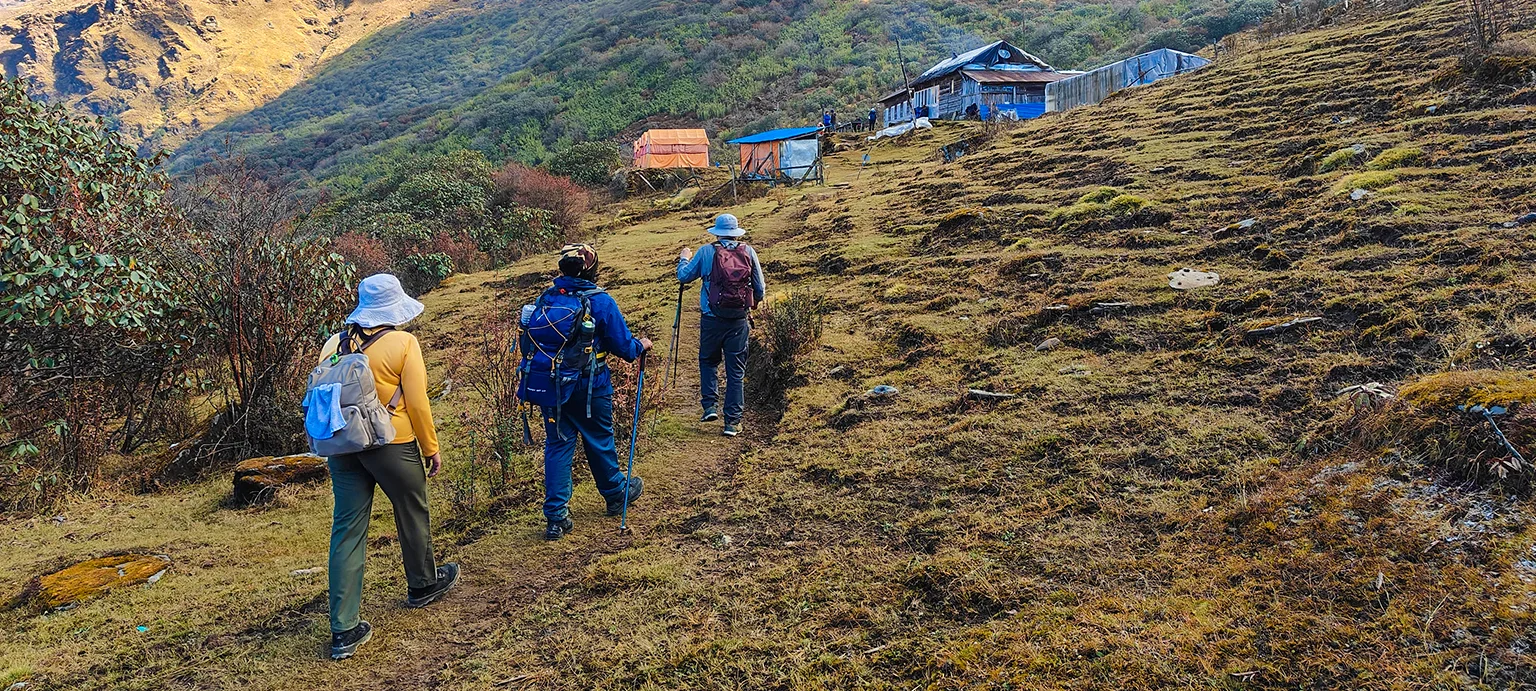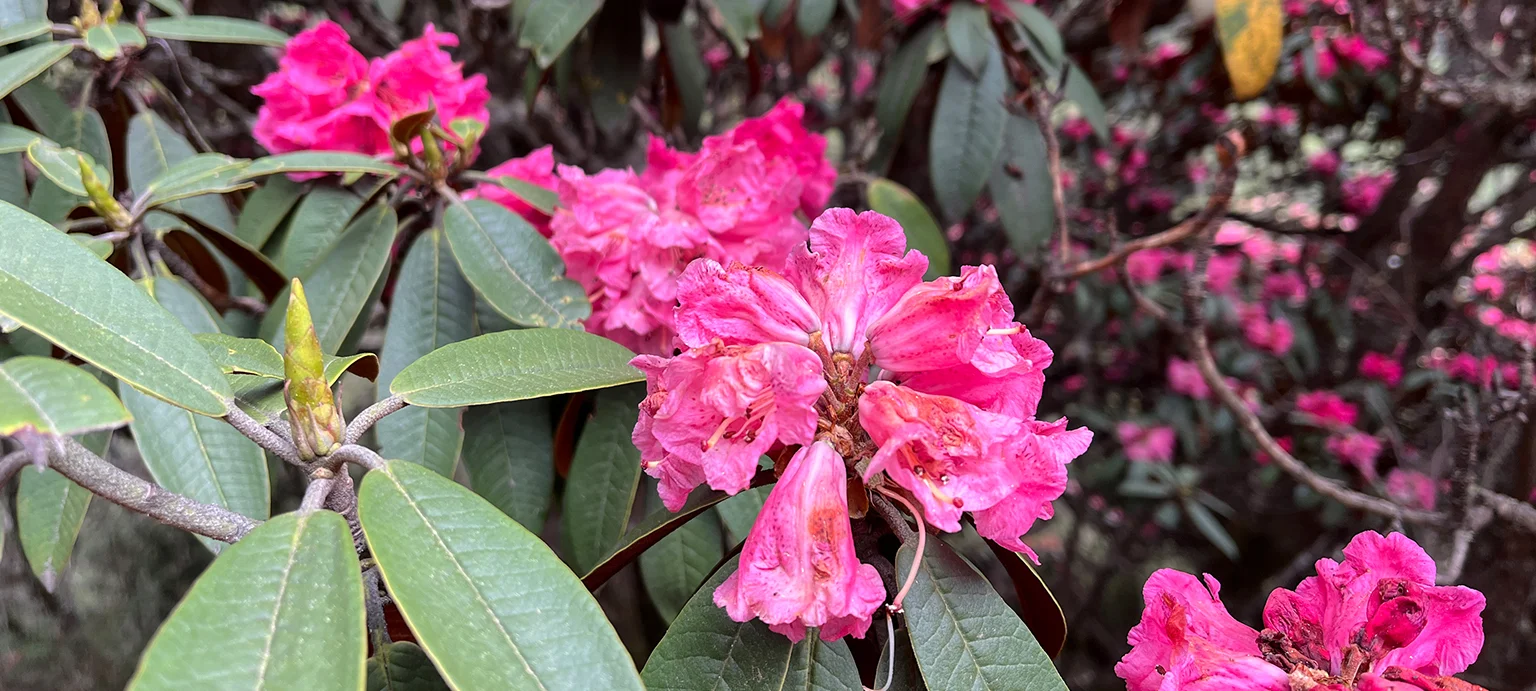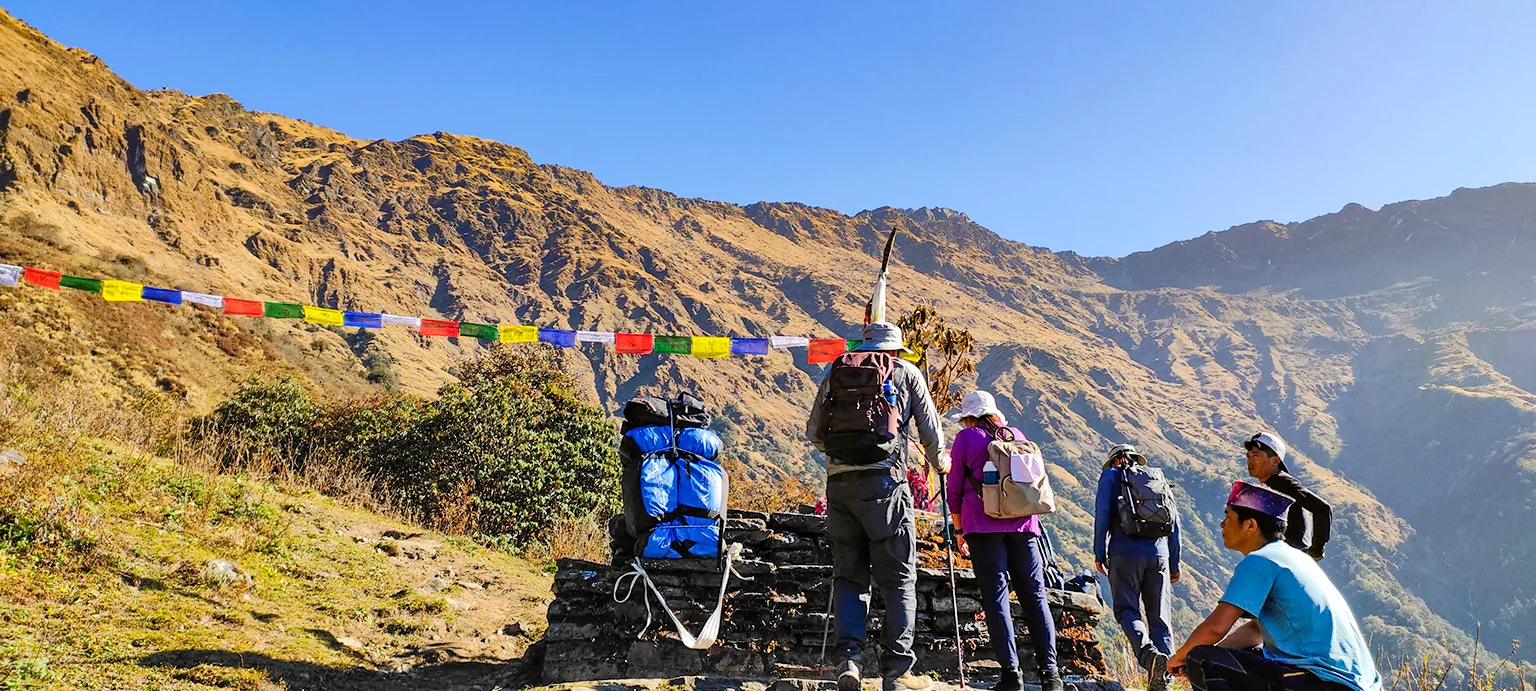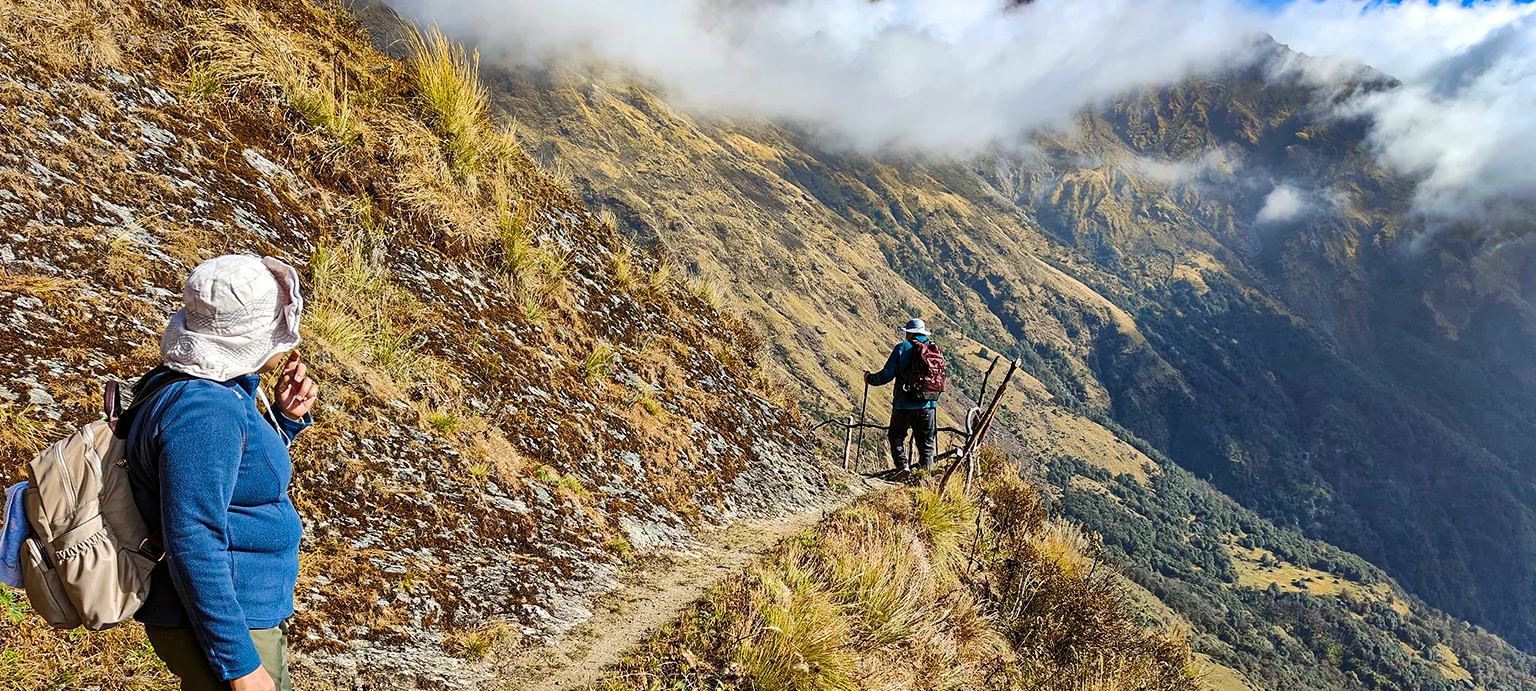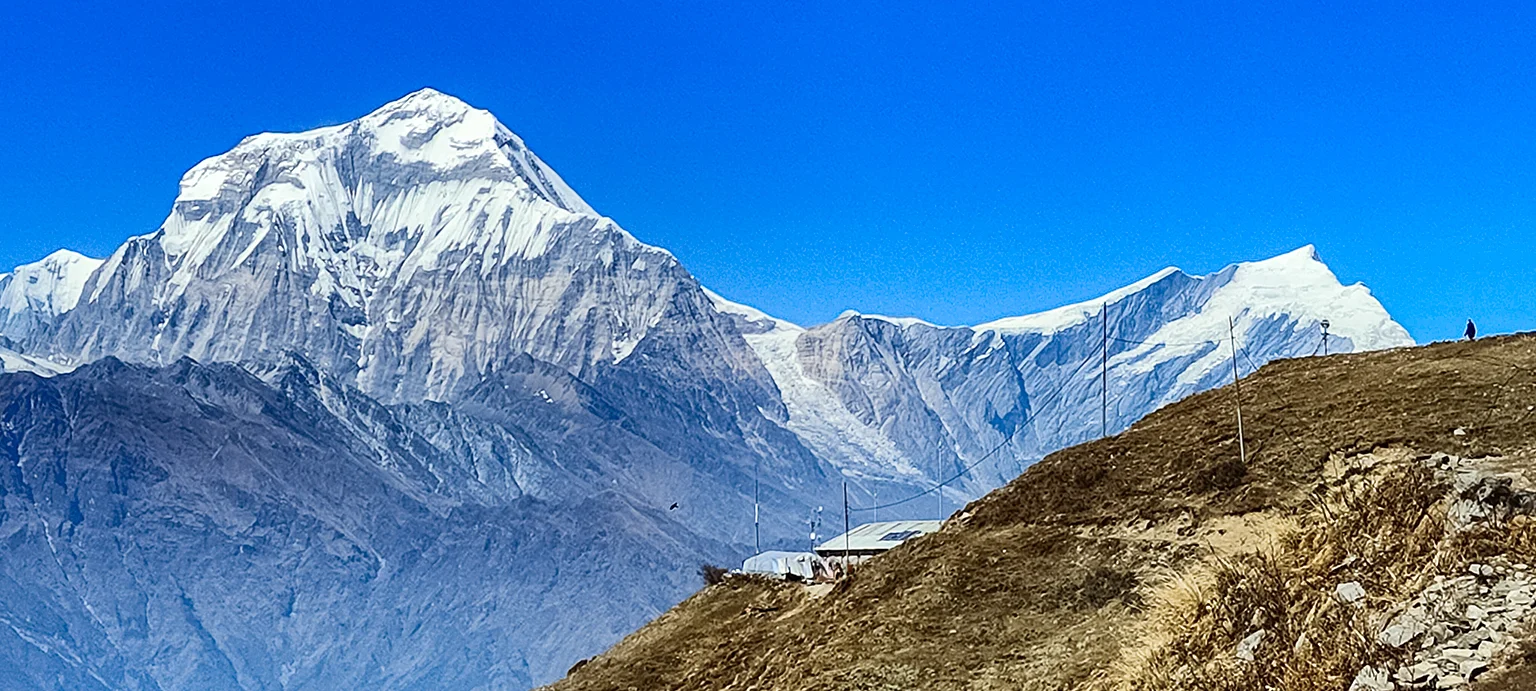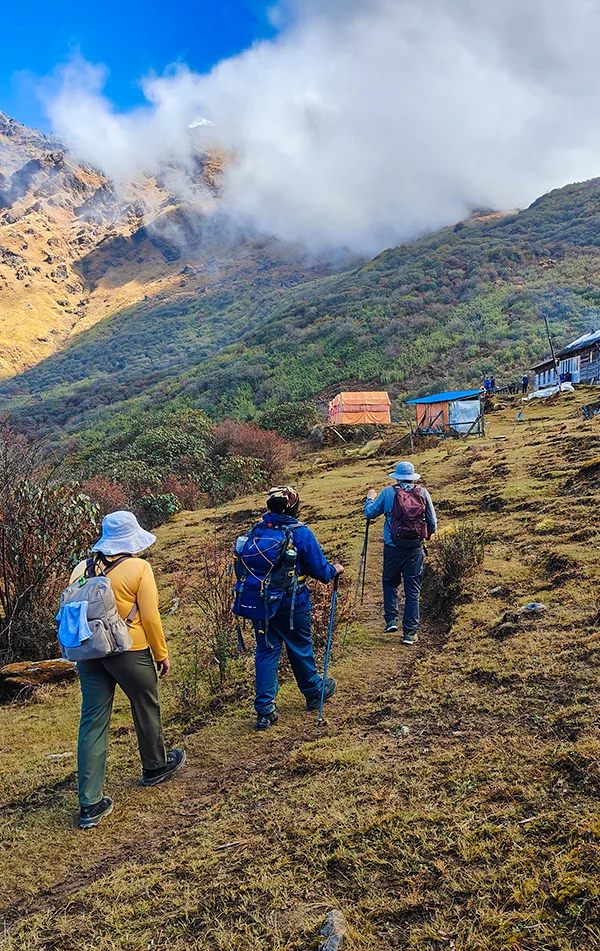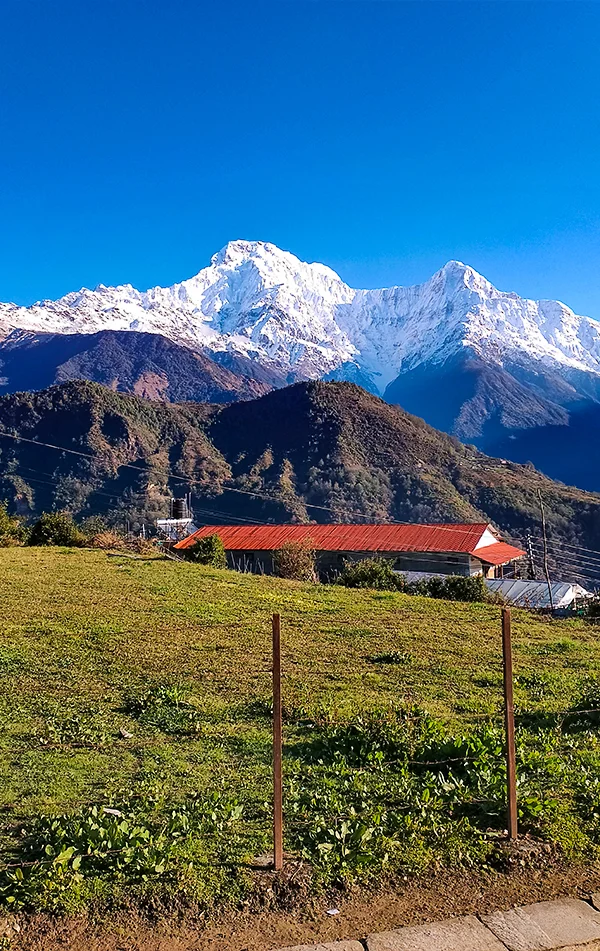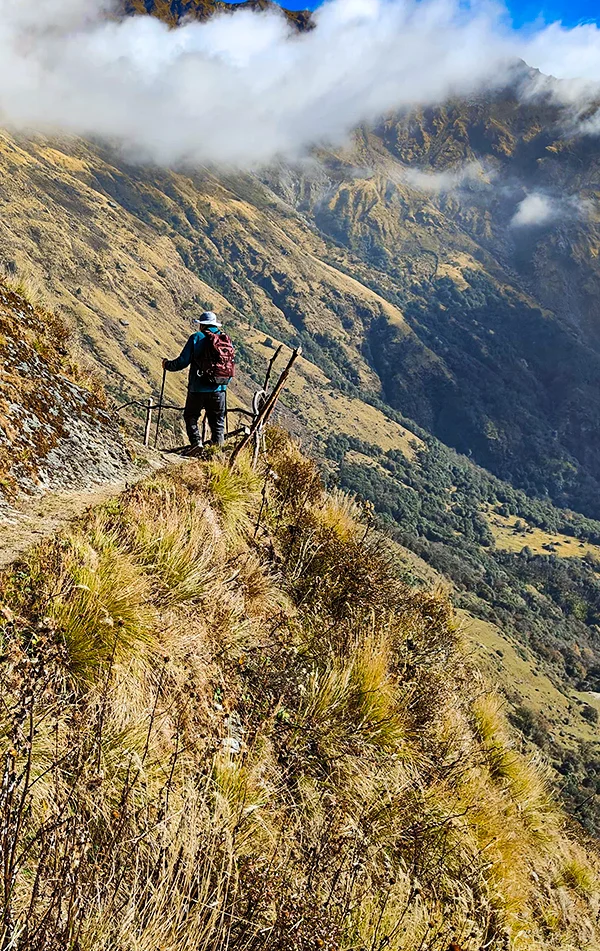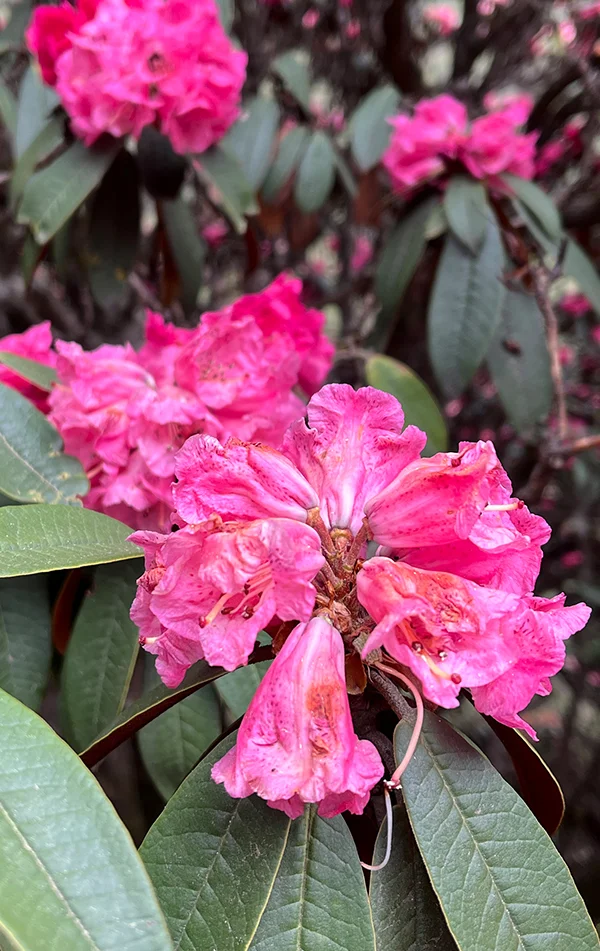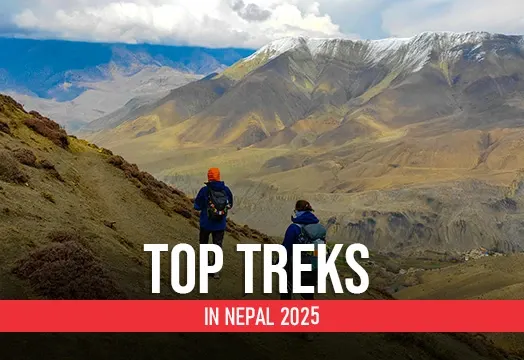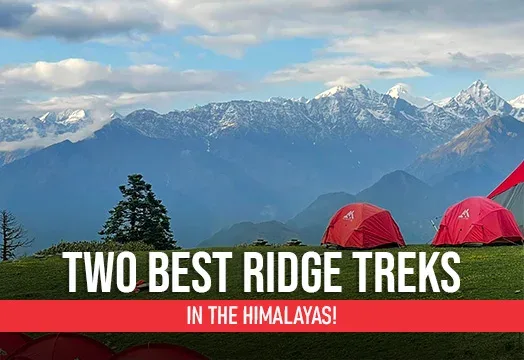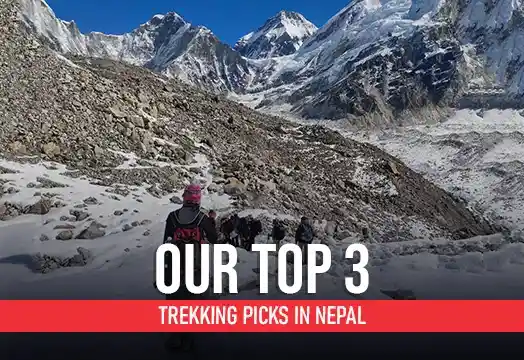Khopra Ridge

Region
Pokhara | Nepal

Duration
9 Days

Max Altitude
15300 Ft.

Trekking Km
50 KM

Grade
Moderate
Get in Touch with Our Trek Expert
91 7351523841 info@trekthehimalayas.comMonday - Saturday: 10 AM to 09.30 PM (GMT +5:30)
Sunday: 10 AM to 05.30 PM (GMT +5:30)
40000 /Person
- March-2026
- April-2026
- May-2026
- USD 480 for Non-Indians and OCI cardholders.
- 5% GST will be applicable on Trek Cost and Add-ons
- Services from Pokhara to Pokhara.
- 2 Night Stay at Pokhara is included
- All Meals are included from Klue to Paudwar
- Farewell Lunch in Pokhara
- Transportation from Pokhara to Pokhara.
Add-ons
Offload 6500
- Backpack offload is optional.
- Choose add-ons during booking. If missed, log in and add them later.
- Book off-load at least 10 days before the trek.
- For offline bookings at the base camp, a convenience fee of Rs. 7800 applies.
- If you cancel your trek prior to the departure date, you will receive a full refund.
- + 5% GST will be applicable
Get in Touch with Our Trek Expert
91 7351523841info@trekthehimalayas.com
Monday - Saturday: 10 AM to 06 PM (GMT +5:30)
Overview
Trek Name: Khopra Ridge
Days: 9
Adventure Type: Trekking
Base Camp: Pokhara
Season:Spring | Summer | Autumn |
Month:April | May | October | November |
Country: Nepal
Altitude: 15300 Ft.
Grade: Moderate
Rail Head: Pokhra
Stay: Hotel and teahouse
Food: Meals while on trek & at Hotel/Guesthouse (Veg & Eggs)
Location: Pokhara
Distance: 50 Km.
Trail Type: One way trail | Camping in various locations, starting and ending at the different point.
AirPort: Pokhara International Airport
Highlights:
- USD 480 for Non-Indians and OCI cardholders.
- 5% GST will be applicable on Trek Cost and Add-ons
- Services from Pokhara to Pokhara.
- 2 Night Stay at Pokhara is included
- All Meals are included from Klue to Paudwar
- Farewell Lunch in Pokhara
- Transportation from Pokhara to Pokhara.
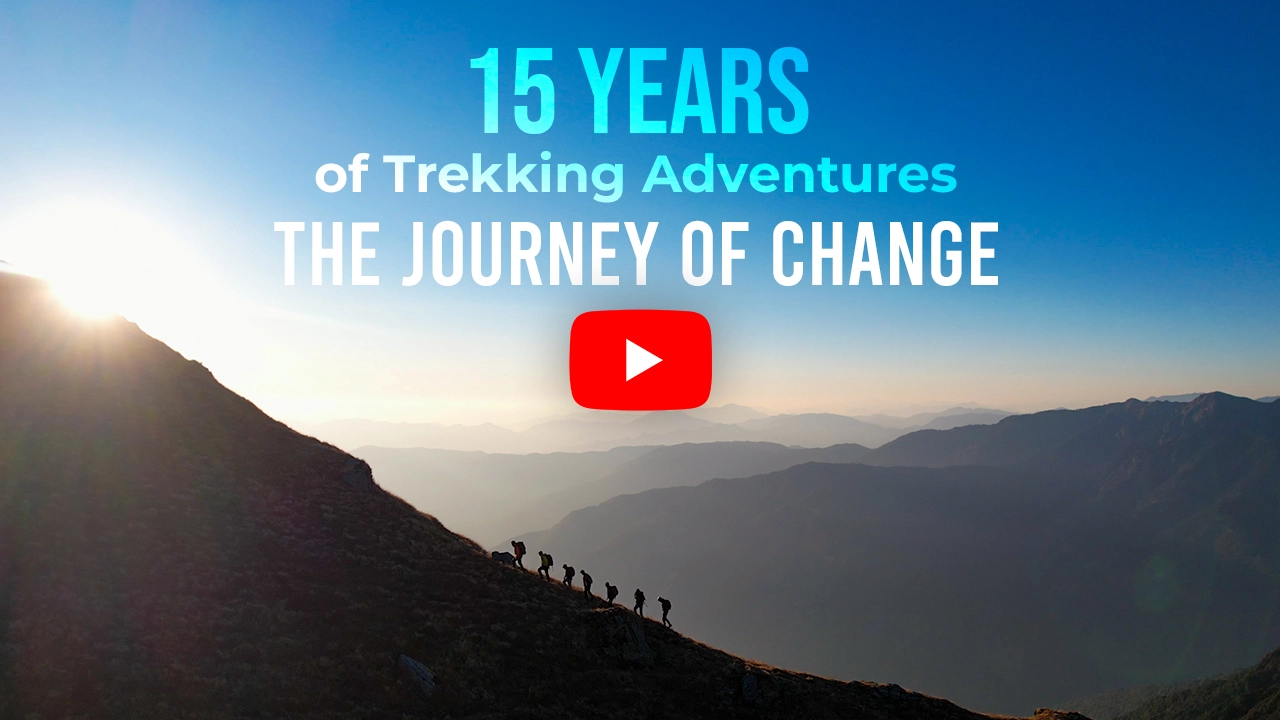
Why is Khopra Ridge Trek a Must-Do?
- Khopra Ridge Trek gives you some of the best Himalayan views, with Dhaulagiri, Annapurna, Nilgiri, and more right in front of you, very few treks offer this kind of panorama.
- Enjoy the serenity of the Khayer Lake, set at high altitude and surrounded by towering peaks.
- Khopra Ridge puts you on a narrow ridge with a closer view of the grand peaks, making you feel like you're walking towards the peaks.
- The villages on this trail are beautiful, giving you a glimpse of authentic mountain life, far from tourist crowds.
- From dense forests to open highlands, to scenic ridge walks, this trek lets you experience a variety.
- Wildlife sightings are common, keep an eye out for Himalayan Tahr, Danphe, and other mountain creatures.
- You’ll get a chance to live the culture, sharing space and stories with Gurung and Magar communities.
- Your stay in community lodges supports the locals directly, making your journey meaningful for you and helpful for them.
- Unlike busy trails like ABC or EBC, this one stays quiet, perfect if you want to explore the lesser strolled trails.
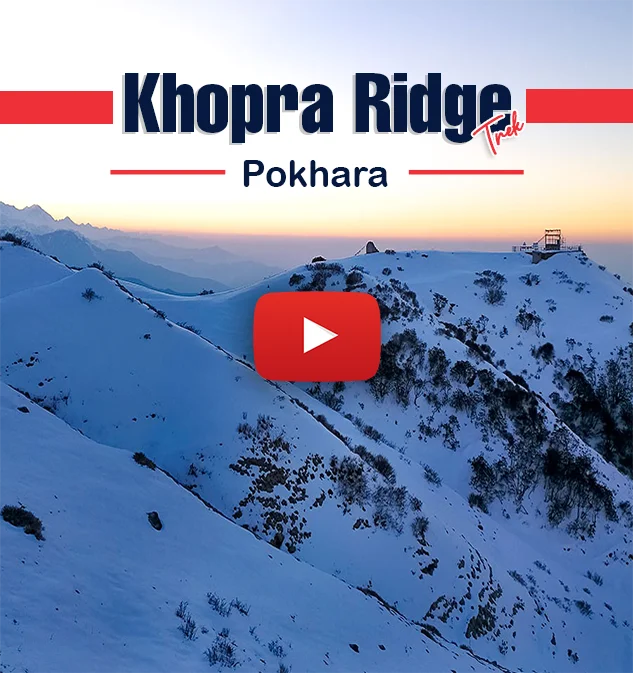
Who Can Participate
- Age Requirement:
- Minimum 12 years
- First-timers are welcome, though prior trekking experience is preferred. Good fitness is a must.
- Fitness Criteria:
- If the trekker wants to carry a backpack then he/she should be able to carry a 10-12 kg backpack. If opt Off-load option then the trekker should be able to carry 3-5 kg backpack.
- If a trekker's BMI is more or less than the normal range (18-28), please consult our Trek Coordinator before booking.
Khopra Ridge Itinerary
Reach Pokhara
- Altitude: 825 m/ 2,700 ft.
- Stay: in the hotel (check-in at 12 noon).
- Briefing about the trek in the evening.
- Sightseeing: Phewa Lake, Tal Barahi Temple, Himalayan Views, International Mountain Museum (not included in the cost).
Pokhara is the base camp for your Khopra Ridge Trek. You have to reach Pokhara by 4:00 pm so that you can attend the briefing session at your hotel. The briefing session will be conducted at 6:00 pm where you will be acquainted with your team, you will be given the necessary instructions and the schedule for the upcoming days.
After the briefing session, you can go for a walk around Pokhara Lake, soak in the beautiful environs of Pokhara, and after a hearty dinner retire early so that you wake up energized for the trek the next day.
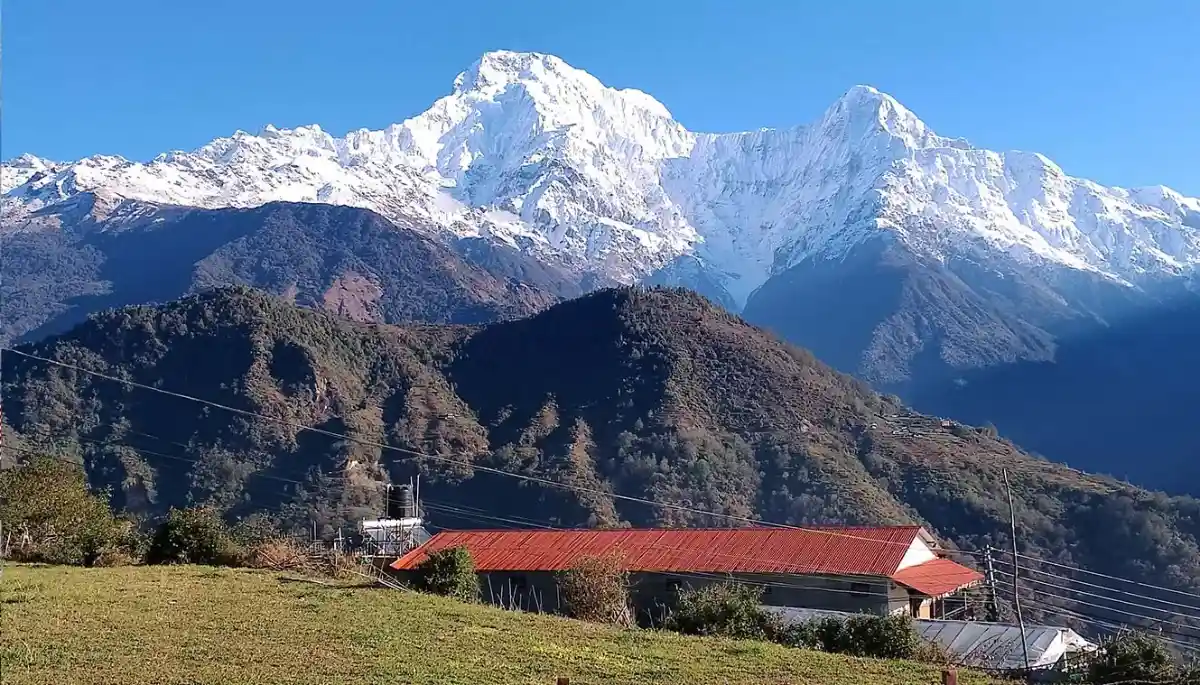
Drive From Pokhara To Klue And Trek To Ghandruk
Today is the first day of trekking and we will start from Kimche. Kimche is a short drive away from Pokhara and it takes about 2 hrs to reach Kimche. From here, the trek starts toward Ghandruk. The trek to Ghandruk is an easy to moderate one with a gradual ascent. Initially, the trail from Kimchee is a little narrow and passes through a small mountain settlement.
As you keep ascending the trail, the mountain views open up and the Modi Khola River flows serenely beside you. If you look on the opposite side of the mountain, you can spot the Mardi Himal trail. Ghandruk starts to come into view about 1.5 hrs into the trek. It is a gradual ascend to Ghandruk from here.
Ghandruk is a panoramic village in the Modi Khola Valley of Nepal. It is the largest village in the Annapurna Conservation area and you can see the old stone and slate-roofed architecture. From Ghandruk, you can see sweeping views of the Annapurna Massif with Annapurna I – the tenth tallest mountain in the world. Here, you can observe the everyday life of the Gurung people of Nepal. The village is lined with prayer flags on all streets with accompanying mountain views making Ghandruk a picturesque and leisurely location where you can feel the serenity of the mountains.
Interestingly, Ghandruk also happens to be a recruitment hub for the British army’s Gurkha soldiers. This allows you to observe and learn about the Gurkha heritage and the community.
Your overnight stay will be in a teahouse or lodge in Ghandruk.
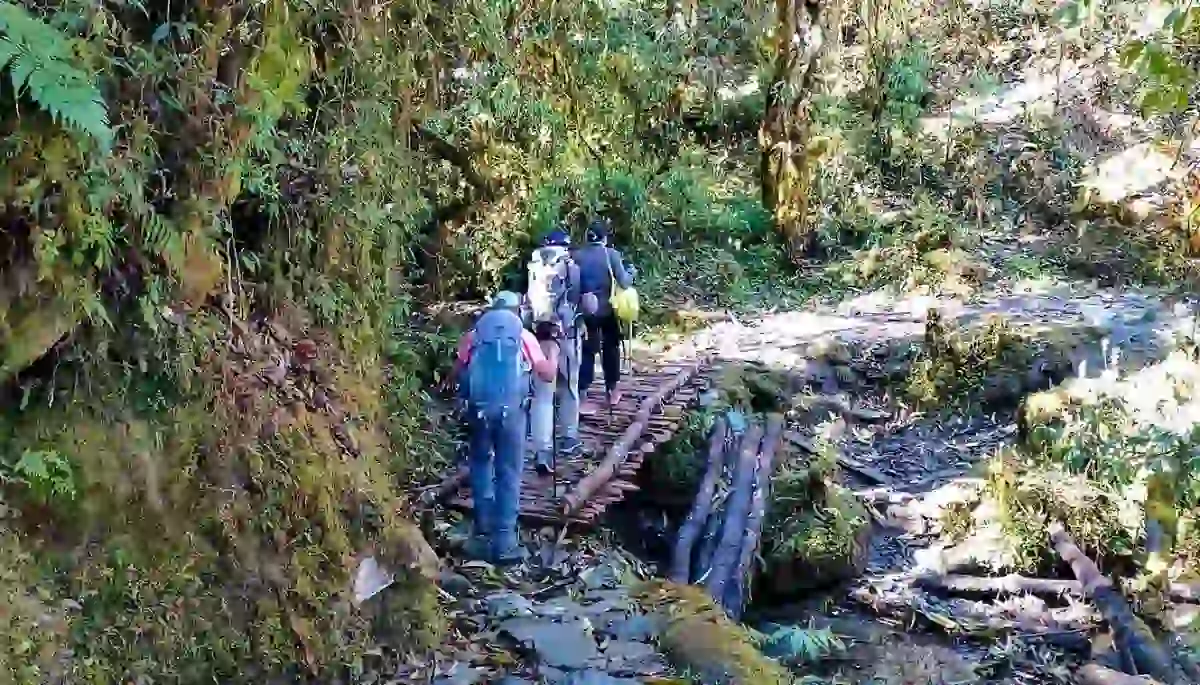
Trek From Ghandruk To Tadapani
Today’s trek will take you from Ghandruk to another mountain hamlet, Tadapani. The inclines are quite steep in places and you will gain around 2500 ft in altitude today. It’s a lovely walk through Rhododendron forests to Tadapani.
Waking up to a beautiful sunrise in Ghandruk, we will have our breakfast and start towards Tadapani. Begin the trek by taking the narrow path that runs through the village. Five minutes into the trek and you will arrive at a junction point. The trail that runs centrally heads towards Kommorong and further on to ABC. We will take the route that heads west to arrive at Tadapani.
The trail is cut into steps so it can be a little hard on your legs. Although you may face a little difficulty ascending 10 minutes into the climb and a surprise waits for you! You arrive at a beautiful viewpoint named the ‘Lovely Viewpoint’ presents stunning views of Mt. Macchapucchre, Mt Annapurna South, Mt Annapurna III, Mt Ganga, and Mt Himchuli.
Continue on the trail and you will enter a beautiful forest of Rhododendron and a variety of other tall trees. Sunlight streams in through the dense canopy making the forest appear sparkling here and there. If you’re trekking in April, the Rhododendron trees are blooming with big red flowers. Continue walking through the forested trail until you reach a small bridge crossing over a stream. The stream is a good source of water and you can refill your water bottles here. After the stream, it is a steep ascent of about 45 minutes. A little more into the trek and you will arrive at a tiny settlement called Bhaisi Kharka, it is a remote village in the far western region of Nepal.
The remaining part of the trek is through similar forested trails that you have encountered before until you arrive at Tadapani. We will have lunch at Tadapani and the stay for the night is arranged in a guest house Tadapni. Mt. Macchapucchare is vividly visible from here and you will end your day with a beautiful sunset view over this majestic mountain peak.
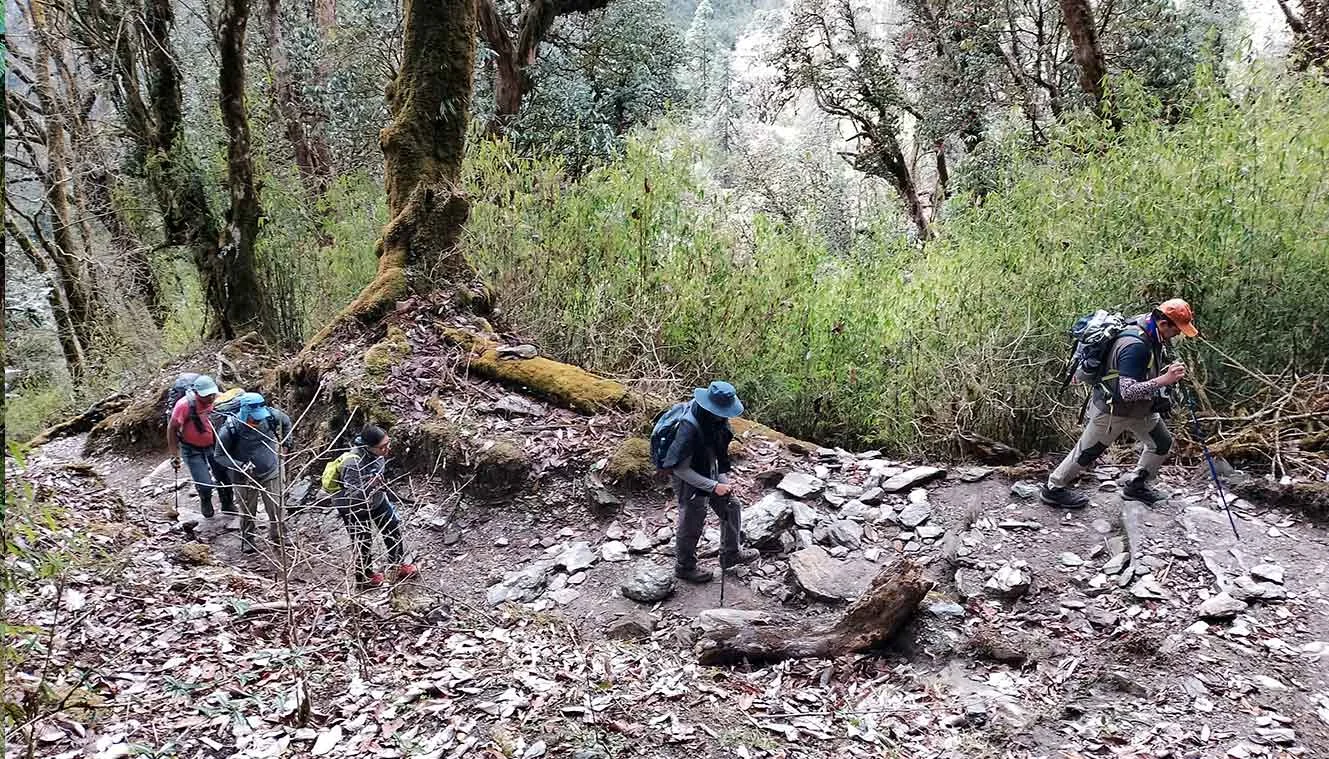
Trek From Tadapani To Dobata
Today again begin your trek through the forested trails of Bamboo and Rhododendrons. Further, into the trail, Oak trees start appearing, and the Annapurna Ranges remain on your right. From this point onwards it is a descent for about 30 minutes and then you start climbing up once again.
An hour’s climb takes you to Meshar where you have your first water source. Fill your water bottles here. From here, you can see grand views of Mt Annapurna Fang, and Mt Annapurna. The two mountains remain visible until you reach Isharu. From Meshar, the trail starts ascending once again, all the way to Isharu. Isharu is another great viewpoint with a staggering panorama of Mt Ganesh Himal, Mt Annapurna II, and Mt Annapurna IV, along with other peaks in the Annapurna Range.
A mix of ascent and descent of about an hour will take you to Dobata. Have a delicious lunch at Dobata and an overnight stay at a teahouse here.
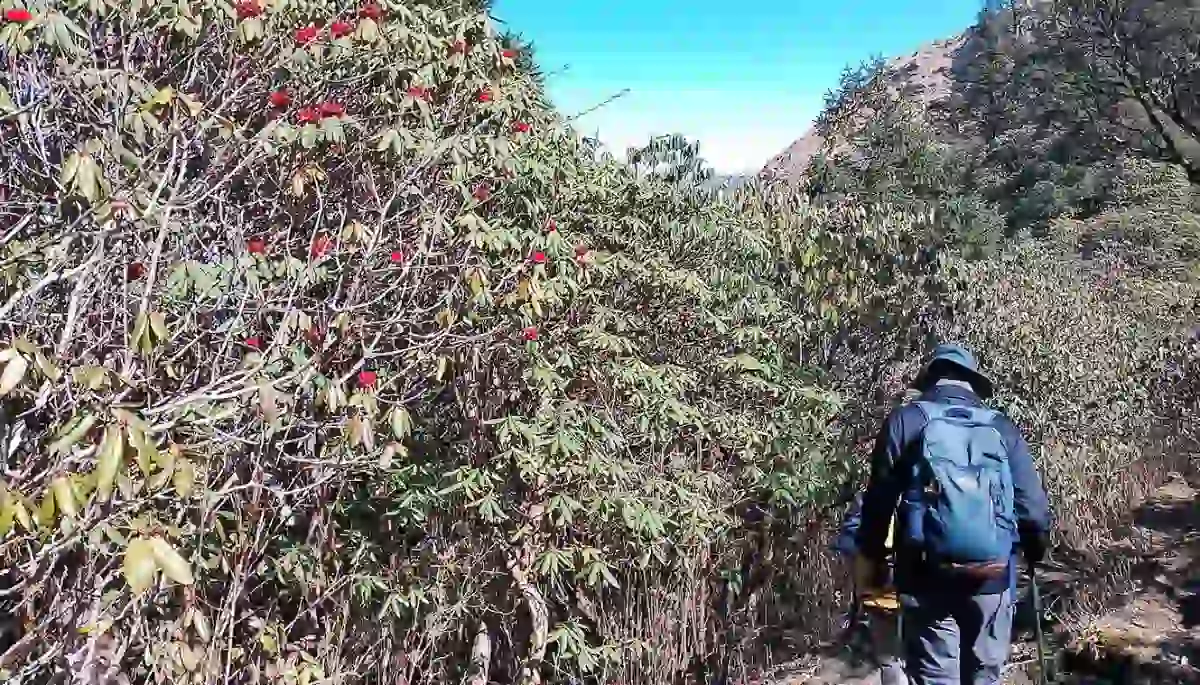
Trek From Dobata To Chhistibang Via Muldai Top
Today is going to be a long day of trekking, so we will start early in the morning. From Dobata, the trail begins with an ascent and after ascending for about 30 minutes, you will arrive at a junction. The trail on the right goes to a hidden lake in the Himalayas and the one straight ahead follows towards Khopra Ridge. We will take the trail that continues toward Khopra Ridge.
As you continue on the trail, the Annapurna Ranges begin to disappear giving way to the Dhaulagiri Range. The appearance of the Dhaulagiri Ranges indicates that you are close to the Muldai Top viewpoint, which lies en route to Chhistibang.
Muldai viewpoint offers a straight-line panorama of 22 mountain peaks. Two of these mountain peaks rank amongst the tallest peaks in the world – Mt Dhaulagiri I (7th highest) and Mt Annapurna I (9th highest). The complete ensemble of Annapurna ranges, Dhaulagiri Range, Mt Nilgiri North & South, and Tukche is a sight that you will never forget in your life.
From Muldai Top, descend for about 2 hrs and you will arrive at Chhistibang. The teahouse here is located in the middle of a forest! Overnight stay will be at Chhistibang before we proceed to Khopra Ridge the next day.
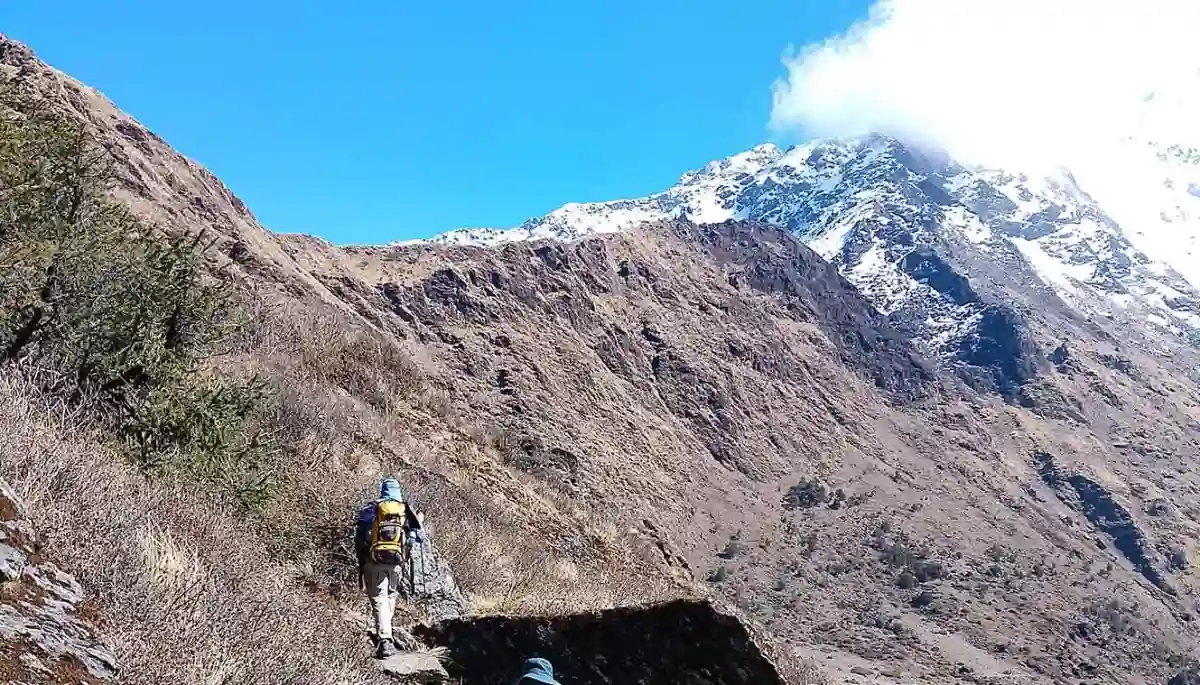
Trek From Chhistibang To Khopra Ridge
From Chhistibang, it is a short trek to Khopra Ridge. Khopra Ridge is about 3.5 km away and takes about 3 hrs to reach the ridge. The trail from Chhistibang to the Khopra Ridge although short is quite steep and you gain an altitude of 200 m every km.
As you walk out of the treeline from Chhistibang, the views become more and more impressive every moment. You will be gazing at snow-capped mountains all around and also come across numerous small streams and waterfalls along the way. The trail will snake around the ridge taking you to a teahouse at the ridge. The teahouse is a viewpoint in itself.
From the ridge, you can see close-up views of the Dhaulagiri Range along with Mt. Annapurna I, Annapurna South, Annapurna Fang, Mt. Nilgiri North & South and Mt Tukuche.
The sunset view here is truly amazing and after the sun sets, the temperature drops drastically, so keep your warm layers on to protect yourself from the cold.
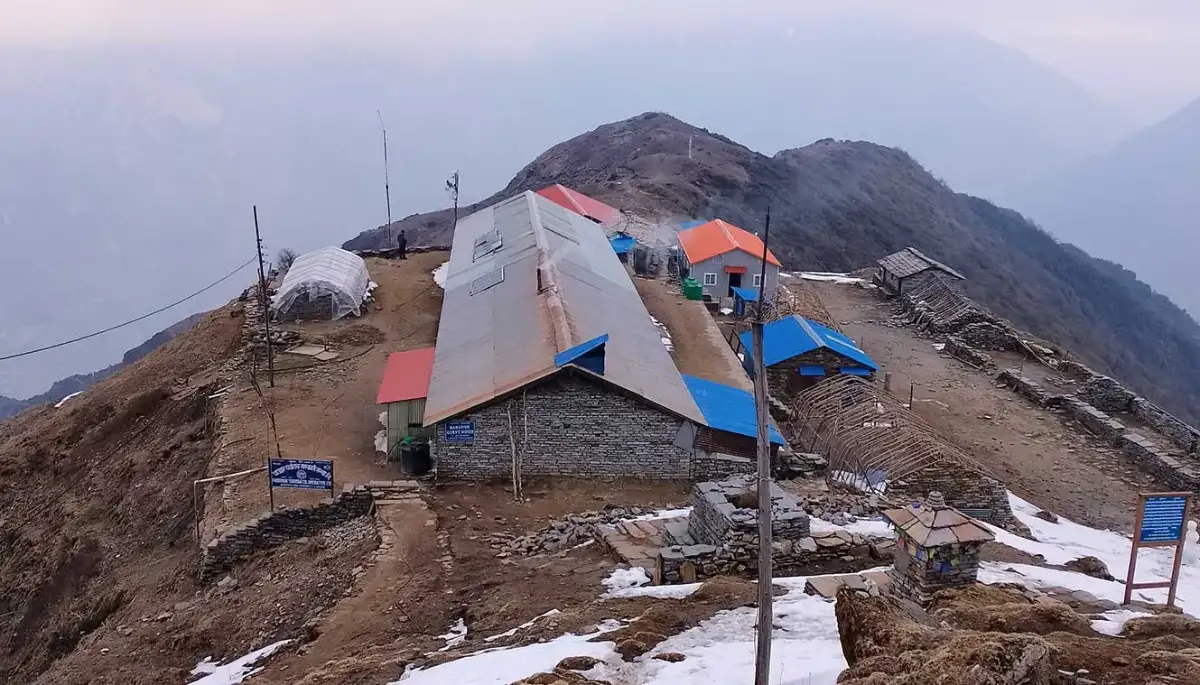
Trek From Khopra Ridge To Khayer Lake And Back To Khopra Ridge
Today we will trek to a high-altitude glacial lake, Khayer Lake. It is a 16 km long trek so we need to start as early as possible. The beginning of the trek is a levelled walk for about 45 minutes. The Dhauligiri Range accompanies you today as well. Soon the trek becomes a mix of ascents and descents. This continues for the next two hours. Look to your left and you will see the deepest valley in the world – the Kali Gandaki. It is located between Mt. Tukuche and Mt. Nilgiri North. It is an intimidating yet incredible sight to behold.
Keep walking and you will soon arrive at barren fields quite similar to the cold deserts of Ladakh and Spiti. This is an indication that you will soon arrive at Khayer Lake. Keep walking and you will arrive at a Dhaba serving tea and snacks. From this point, it is another 1.5 hr trek to the lake. From here, it is a continuous ascend on steps and along the way, you will get to see symbols of bells and temples. These symbols represent the mythological tales of the region. The lake is situated at the foot of Mt. Annapurna South and the mountain looms large above the lake - a majestic sight to behold!
We will spend some time at the lake, post which we will return back to the ridge. It will take about 3.5 hrs to return to Khopra Ridge. Enjoy a beautiful sunset view as you descend down the trail.
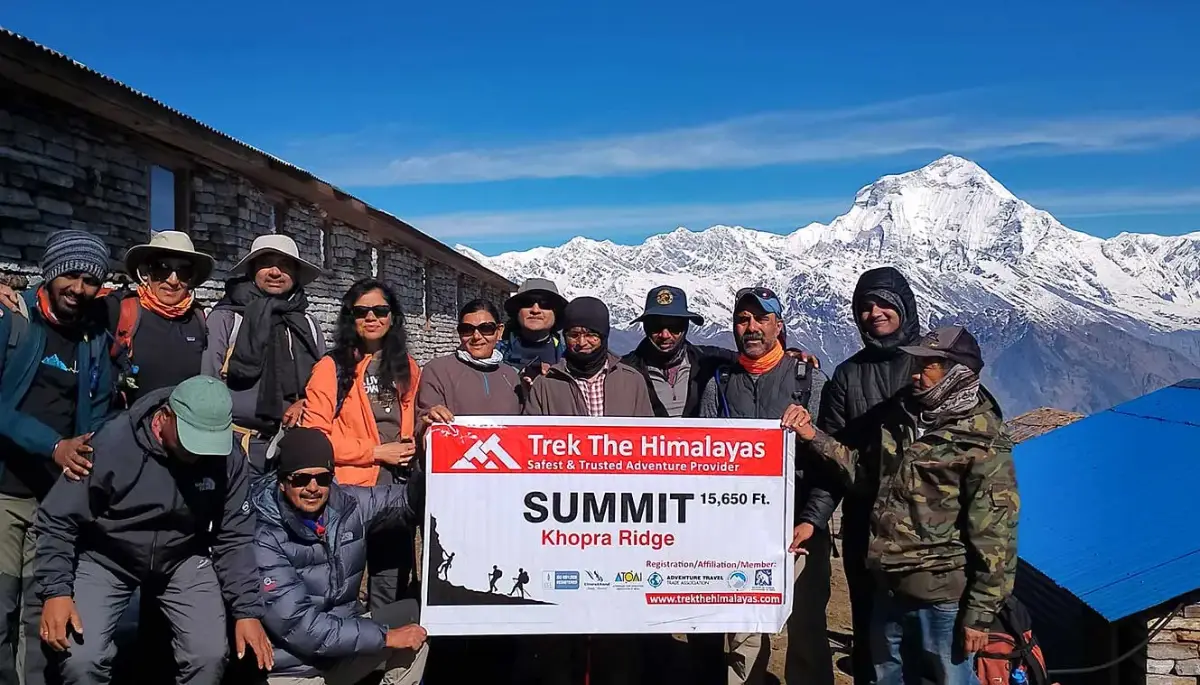
Trek From Khopra Ridge To Paudwar Via Gorge Point
The trek from Khopra Ridge to Paudwar takes about 6.5 hrs and you will cover a distance of 8.5 km. The trek starts with a gradual descent and soon you will arrive at a forest covered with Rhododendrons. During the months of March and April, the forest is bedecked with blossoming red, pink, purple, and white Rhododendrons. Crossing the forest, you arrive at a teahouse at Loreni which is about 2 hrs above Paudwar. There’s a teahouse at Loreni as well. From Loreni, the trail winds along the hills of the Jarbhang Valley into a patch of bamboo forest and cow pastures. Crossing this section of the forest, it is a steep descent all the Paudwar.
Paudwar is a scenic traditional village belonging to the Magar community of Nepal. The lovely hamlet showcases the ancient Nepali stonework architecture in its houses. All the houses here are more than 80 years old. The people here are very friendly and welcoming. The labyrinthine paths, the winding staircases, and the stonework architecture of Paudwar make it worth the effort of the trek. Tonight, you will stay in a homestay at Paudwar.
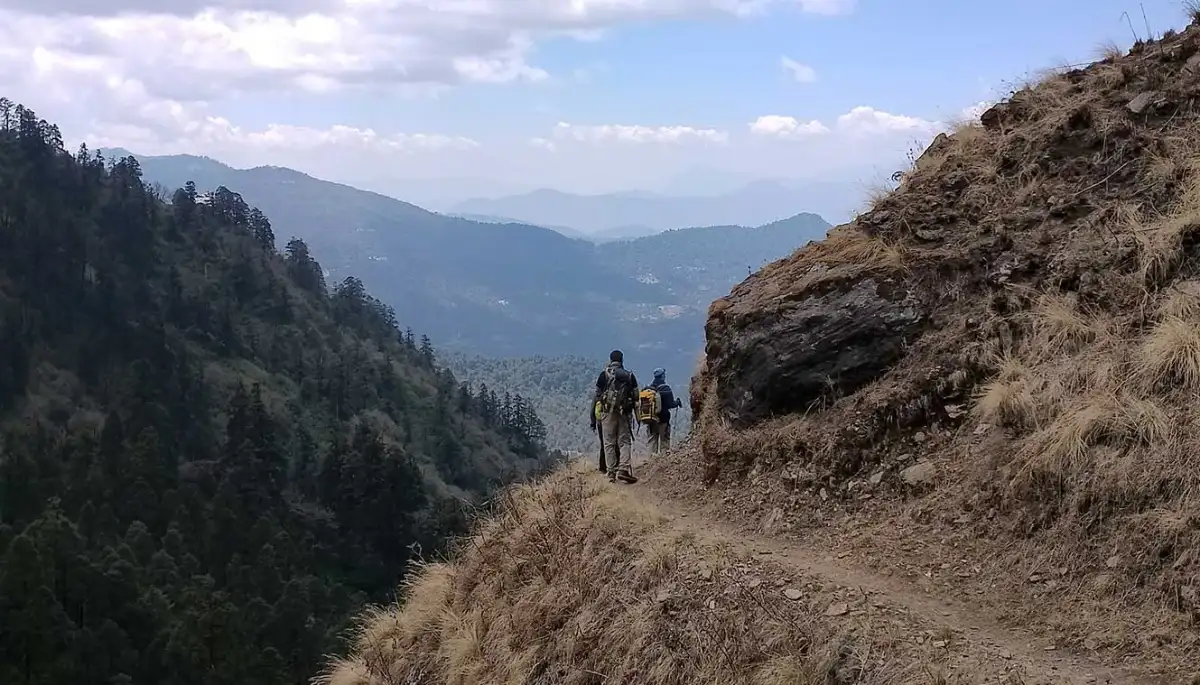
Trek From Paudwar To Tatopani And Drive To Pokhara
This is the last day of your trek and we will trek down from Paudwar to Tatopani and drive back to Pokhara. Tatopani village falls on the old route to Mansarovar Lake. It is an easy descent from Paudwar to Tatopani. You will descend through a forested trail for about 2 hrs and once the treeline recedes, you will walk alongside a stream until you reach Tatopani. The Khopra Ridge Trek ends here. From here, you will be driven back to Pokhara, which is approximately 110 km away from Tatopani and the drive takes about 5 hrs.
Note:
- Keep 1-2 buffer days in your travel plan.
- If buffer days are not used in the travel then it can be used to explore Pokhra.
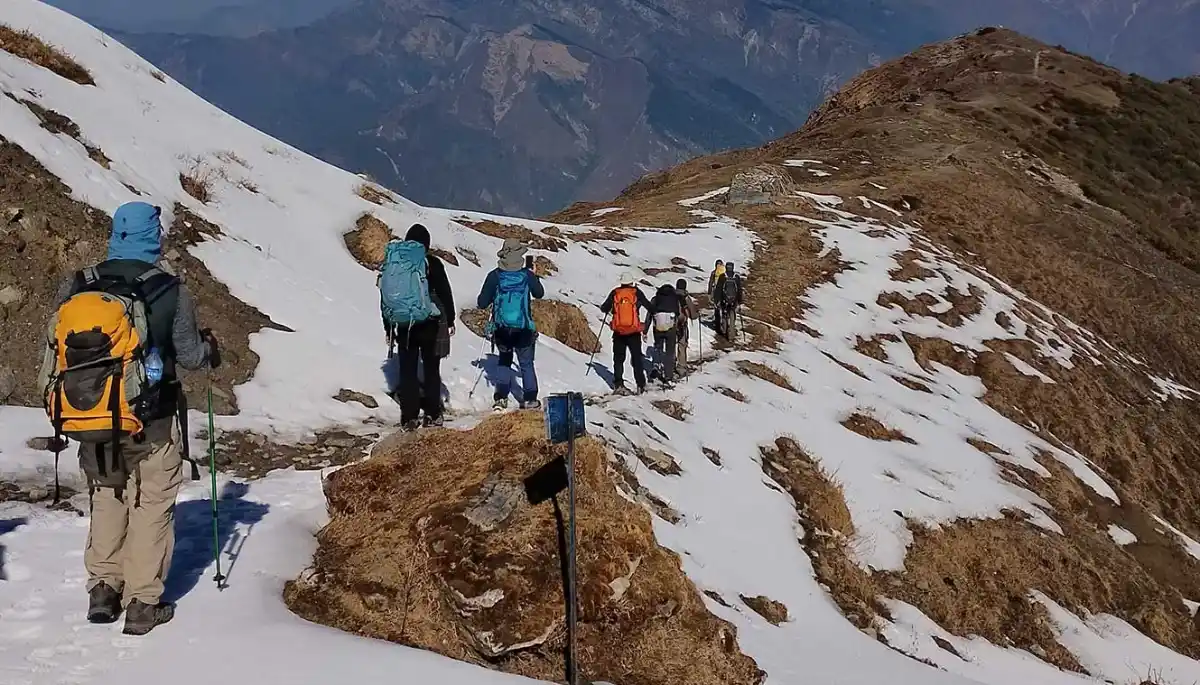
Day-1: Reach Pokhara
- Altitude: 825 m/ 2,700 ft.
- Stay: in the hotel (check-in at 12 noon).
- Briefing session at the guesthouse/hotel in the evening.
- Stay in Hotel.
Day-2: Drive From Pokhara To Klue And Trek To Ghandruk
- Altitude Ghandruk: 2,000 m/ 6,500 ft.
- Altitude(Klue): 1,800 m/ 6,000 ft.
- Drive to Klue: 48 km | around 2 hrs.
- Trek Distance: 7 km | Duration 4-5 hrs.
- Highlights of the trek: Stunning mountain views.
- Stay: Teahouse/ lodge.
Day-3: Trek From Ghandruk To Tadapani
- Altitude: 8,700 ft.
- Trek Distance: 6-7 km | Duration: 4-5 hrs.
- Grade: A mix of level walks and gradual ascents.
- Stay in Teahouse.
Day-4: Trek From Tadapani To Dobata
- Altitude: 11,250 ft.
- Trek Distance: 6 km | 6 hrs.
- Grade: Moderate to difficult.
- Witness a series of major mountain views.
- Stay in Teahouse.
Day-5: Trek From Dobata To Chhistibang Via Muldai Top
- Altitude: 9,900 ft (Chhistibang) | 11,900 ft (Muldai Top).
- Trek Distance: 9 km | Duration: 6-7 hrs.
- Grade: Ridge walk with steep ascents.
- Stay in Teahouse.
Day-6: Trek From Chhistibang To Khopra Ridge
- Altitude: 12,000 ft.
- Trek Distance: 4 km | Duration: 3 hrs.
- Stay in Teahouse.
Day-7: Trek From Khopra Ridge To Khayer Lake And Back To Khopra Ridge
- Altitude: 15,300 ft.
- Trek Distance: 16 km | Duration: 8-9 hrs.
- Grade: A gradual ascent that becomes steeper as you gain altitude.
- Highlight of the trek: An alpine lake at the foothills of Mt. Annapurna South.
- Stay in Teahouse.
Day-8: Trek From Khopra Ridge To Paudwar Via Gorge Point
- Altitude: 6,600 ft.
- Trek Distance: 8-9 km | 6-7 hrs
- Stay in a homestay.
Day-9: Trek From Paudwar To Tatopani And Drive To Pokhara
- Altitude: 3,900 ft (Tatopani) | 2,760 ft (Pokhara).
- Trek Distance: 5 km | Duration: 3 hrs.
- Drive Distance: 110 km | Duration: 5 hrs.
- Grade Gradual descent through forests.
Note:
- Keep 1-2 buffer days in your travel plan.
- If buffer days are not used in the travel then it can be used to explore Pokhra.
Khopra Ridge Graph
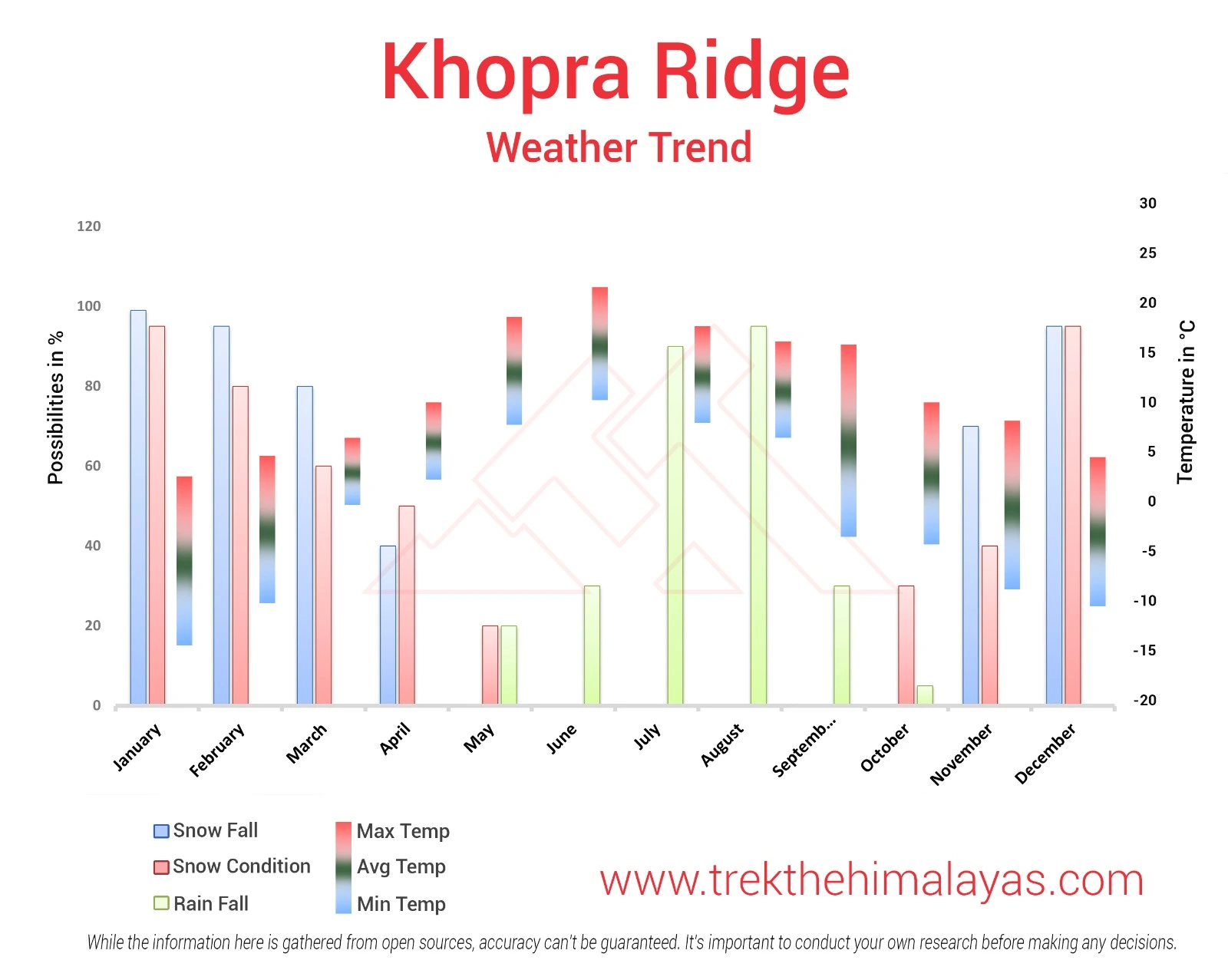
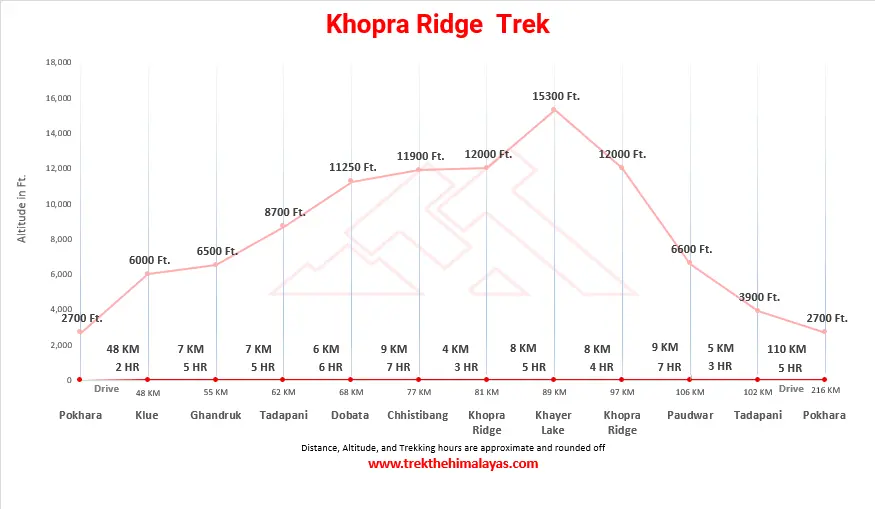
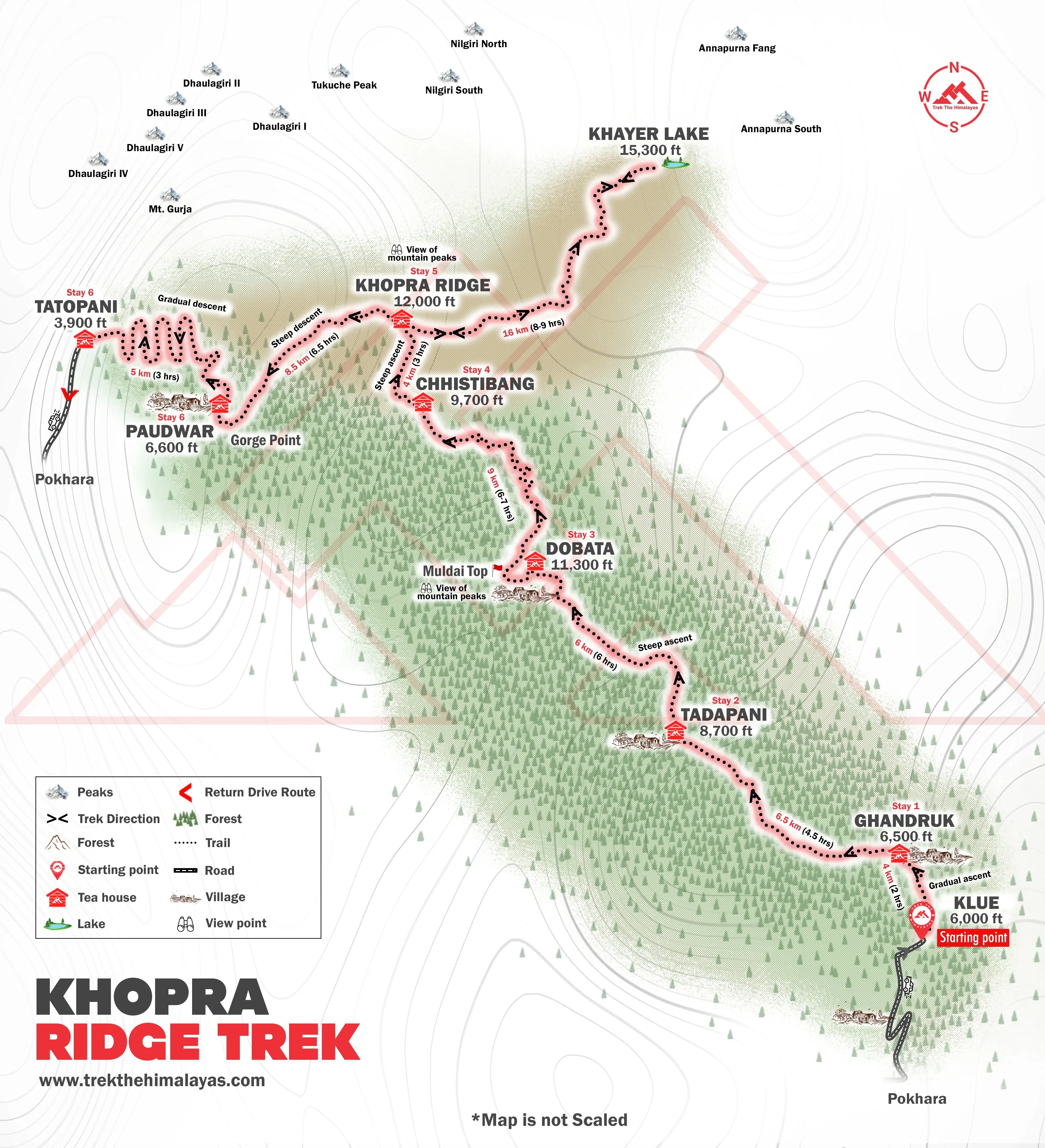
- Pulse rate at rest must be in between (60 to 100 beats per minute).
- Blood Pressure Reading must be in between (DIASTOLIC 75 – 85, SYSTOLIC 100 - 130 mm Hg).
- Respiratory rate at rest must be in between (12 to 20 breaths per minute).
- Should not have Liver and kidney issues.
- Should not have Diabetes Mellitus, Bronchial Asthma, Heart problems, Hypertension, etc.
- No pacemaker implant.
- People with Sinus issues, Epilepsy please contact to trek coordinator before booking the trek.
- If your BMI is not normal, Please contact our Trek coordinator before Trek booking.
Medical & Disclaimer Form (Mandatory Documents) Click here to download Medical & Disclaimer Form
- Junior trekkers (below 15 years) should have a company of parents/guardians.
- Trekkers between 15 to 18 years can come solo with the disclaimer form signed by parent/guardian.
- Medical & Disclaimer Form (Mandatory Documents) Click here to download Medical & Disclaimer Form
Important Links
- Mandatory Documents to Bring on A Trek Click Here.
- How to pay Add-ons, Submit Medical Forms, and Dietary Preferences Click Here to watch Video
How To Reach
Pick-Up Information
- It is essential for everyone to arrive at Pokhara (1:00 pm).
- Upon booking the trek, you are required to come to our hotel. Your trek coordinator will provide you with details such as the name of the Pokhra hotel, its location, and the contact person's number.
Options to Reach Pokhara
- By Flight
Tribhuvan International Airport is the only International airport located in Kathmandu, Nepal. One can fly to Tribhuvan airport and then can take an additional flight to Pokhara. The distance between Pokhara and Kathmandu is around 200 kms and can be covered in 30 minutes. Popular airlines such as Buddha Air, Yeti Airlines, and Simrik Air serve this Pokhara route.
- By Train
There is no train option travelling to Pokhara, Nepal. The closest railway stations which one can arrive at are Jaynagar, New Jalpaiguri or Gorakhpur (INDIA). From there crossing the corresponding borders of Panitanki or Sunauli, one can take a bus to Pokhara via Kathmandu.
- By Bus
One can directly travel to the cities like Gorakpur or Varanasi in Uttar Pradesh, and by crossing the Sunauli border can catch a bus or book a private car to reach Pokhara. The journey will take upto 8 hours to complete. Or one can fly to Kathmandu and then take public or private transport to Pokhara. The distance between these two cities is 200 kms which may take upto 6 to 7 hours.
For your return journey from Pokhara, you have the flexibility to choose between road or air transport options. Please note that our services extend only to the hotel, and the standard hotel check-out time is 11:00 am.
.webp)
Cost Terms
Inclusion
1. Accommodation (as per the itinerary):
- Day 1 and Day 9 Stay in 3 Star Hotel in Pokhara with Breakfast
- Day 2 to Day 8 Teahouse.
2.Meals (Veg + Egg):
- 3 Cups of Tea/Coffee with Meal, Fresh Fruit after Dinner.
- Day 2 Lunch to Day 9 Breakfast, Tea & Cookies on arrival at Tea Houses.
- Farewell Lunch in Pokhara
3. Transportation (as per the itinerary):
- Pokhra to Nayapul and return.
4. Support:
- 1 Versatile base camp manager: handles communication and deploys extra manpower in emergencies.
- 1 Mountaineering & First aid qualified professional expedition Leader.
- 1 Experienced high altitude chef.
- Local experienced guides (Number of guides depending on the group size).
- Enough support staff.
5. Trek equipment:
- Sleeping bag.
- Climbing Boots, Gaiters & Crampon /micro spike (if required).
6. First aid:
- Medical kit, Stretcher, Oxygen cylinder, Blood pressure monitor, Oximeter, Stethoscope.
7.Cloakroom service at base camp.
8. All necessary permits and entry fees, Upto the amount charged for Indian.
9. Services from Pokhra to Pokhra.
10. Store room facility in Pokhra for extra luggage.
11. TIMS card.
12. Entire Administration and Local Taxes.
13.Trek Completion Certificate.
Exclusion
1. Insurance (Mandatory).
2. Food during the transit.
3. Any kind of personal expenses.
4. Mule or porter to carry personal luggage.
5. Emergency evacuation, hospitalization charge or etc.
6. Anything not specifically mentioned under the head Inclusion.
7. Porters for the personal bag*.
8. Wi-Fi, charging batteries and hot showers, warm water for drinking.
9. Nepal entry visa (approximately $40 USD) only for foreigners (Not for Indians).
10. Unforeseen costs due to flight cancellation, weather conditions, etc.
Things can be provided on demand and availability (participant has to pay extra for these things).
1- Satellite phone/set phone - is a type of mobile phone that connects via radio links via satellites orbiting the Earth instead of terrestrial cell sites like cellphones. Therefore, they can operate in most geographic locations on the Earth's surface.
2- Gamow/PAC HAPO Bag (Portable Hyperbaric Bag) - is a unique, portable hyperbaric chamber for the treatment of acute mountain sickness (AMS), also known as altitude sickness.
3- AEDs (Automated External Defibrillators) - are portable life-saving devices designed to treat people experiencing sudden cardiac arrest, a medical condition in which the heart stops beating suddenly and unexpectedly.
Cancellation Terms
To request a cancellation, please email us at info@trekthehimalayas.com using your registered email ID.
Cancellations prior to 25 days from the start of the Trip
Refund Options
- 5% deduction of trek fee
- 100% trek fee cash voucher for any trip till one year
- Transfer your trek (any trek, any date) to your friend
Cancellation between 24 days and 15 days to the start of the Trip
Refund Options
- 30% deduction of trek fee
- 100% trek fee cash voucher for same trip till one year
- 85% trek fee cash voucher for any trip till one year
- Transfer your trek (same trek, any date) to your friend
Cancellation between 14 days and 10 days to the start of the Trip
Refund Options
- 50% deduction of trek fee
- 80% trek fee cash voucher for same trip till one year
- 70% trek fee cash voucher for any trip till one year
- Book the same trek, in the same season, with any other batch
- Transfer your trek (same trek, any date) to your friend
Cancellation less than 9 days to the start of the trek.
Refund Options
- No cash refund
- 20% trek fee cash voucher for the same trip till one year
- 10% trek fee cash voucher for any trip till one year
- Transfer your trek (same trek, same date) to your friend
- To reschedule a trek (same trek only), a 30 % rescheduling fee of the trek cost will apply.
Cancellation Policy (Emergency Cases):
In case of a death in the immediate family (parents, siblings, spouse, children) or if the trekker is hospitalized (min. 48 hours) or suffers a fracture (leg/arm) within a week before the trek, even if canceled a day before:
90% trek fee refund in cash & 10% as a voucher (valid for 1 year, for any India trek).
Valid documents required. We’re here to support you during tough times.
Note:
- Change of trek batch is dependent on the availability of seats in the batch
- In case of transferring a trek to a friend, he/she should satisfy all the mandatory requirements put forward by TTH
- TTH holds the right to change/cancel the policies, without prior notice
Booking and Payments
- The Participant is responsible for verifying the accuracy of all details, including Trip dates and personal documentation, at the time of booking.
- Payments must be made in accordance with the timelines and instructions provided by TTH. Late payments may result in cancellation of booking without refund.
- In the event of a cash refund, only the portion of the payment made in cash shall be eligible for refund in cash. Any booking made using voucher, discounts, promotional codes, or through any non-cash mode of payment shall not be eligible for a cash refund under any circumstances.
- Refunds, if applicable, shall be processed within 15–30 working days of confirmation.
- All add-on bookings are subject to the respective add-on cancellation policy, and refunds will be processed accordingly.
- Voucher Terms
- This is a non-transferable voucher
- The voucher cannot be merged with any other offer of Trek The Himalayas
- The voucher is valid for Trek booked directly with Trek The Himalayas in India
- To avail the voucher please use your register phone number or e-mail id
- All the other Terms of booking a trek with Trek The Himalayas are applicable to the voucher
Itinerary and Modifications
- TTH reserves the right to modify, shorten, or cancel any part of the Trip due to transportation delays, weather, health emergencies, or other unforeseen circumstances including Force Majeure.
Cancellations and Refunds
- No refunds or vouchers, partial or otherwise, shall be provided for voluntary withdrawal, non-utilisation of services, or removal from the Trip.
- If TTH cancels the Trip before arrival at the designated pick-up point due to unforeseen circumstances or Force Majeure, the Participant may choose from:
- An alternate Trip/date.
- A credit voucher valid for one (1) year.
- Transfer to another Trip, with cost differences payable by the Participant.
- If the Trip is abandoned post-arrival at the designated pick-up point, no cash refund or voucher shall be issued. The Trek Again Policy may apply at TTH’s discretion.
- TTH shall not be liable for any associated travel costs such as flights, accommodation, or visa fees.
Force Majeure
- Events beyond its control including but not limited to earthquakes, landslides, strikes, curfews, war, pandemic, government restrictions, heavy rainfall or snowfall, windstorms, road blockages, trail disruption, or withdrawal of permits, TTH shall not be held liable for any cancellation, delay, or service modification caused by Force Majeure.
Trek Essentials
Rent EquipmentPDF Of Trek Essential Download
| Backpack with rain cover | (50 - 60 ltr) with comfortable shoulder straps |
| Day pack with rain cover | 20 - 30 ltr (If off-load opted) |
| Walking stick | Advisable (At least one) |
| Water Bottle / Hydration pack | 2 bottles of one liter each, People who use hydration pack 1 hydration pack and 1 bottle of one liter, Carry at least one thermos flask. |
| Small size tiffin/lunch box | 1 Nos |
| Snacks | Energy bars, dry fruits, electral/ors |
| Personal Medical Kit | Consult your doctor |
| T-Shirt (Synthetic quick dry) | 1 Full & 2 Half sleeves |
| Fleece T-shirt | 1 Nos |
| Fleece jacket | 1 Nos |
| Windproof Jacket | 1 Nos |
| Down feather / Hollow jacket | 1 Nos |
| Thermal inner (Upper and Lower) | 1 Pair |
| Trek Pant (Synthetic quick dry) | 2 Nos |
| Fleece Pant | 1 Nos |
| Waterproof gloves | 1 Pair |
| Fleece / woollen gloves | 1 Pair |
| Poncho / waterproof Jacket and pant | 1 Nos |
| Sunscreen | 1 Nos |
| Moisturiser | 1 Nos |
| Chap-stick / Lip balm | 1 Nos |
| Toothbrush and toothpaste | 1 Nos |
| Toilet paper & Wipes | 1 Nos |
| Soap / hand sanitizers | 1 Nos |
| Antibacterial powder | 1 Nos |
| Quick dry towel | 1 Nos |
| Head torch | 1 Nos. (Avoid Hand torch) |
| Sun Cap | 1 Nos |
| Woolen cap | 1 Nos. |
| Balaclava | 1 Nos. |
| Buff / Neck-gaiters | 1 Synthetic & 1 Woollen |
| Sunglasses | UV with dark side cover, People who wear spectacles - (A)- Use contact lenses | (B)- Photo chromatic glasses |
| Trekking shoes | 1 Pair (Water-resistant, high ankle, good grip) |
| Floaters / flip-flops | 1 Pair |
| Cotton socks | 6 pairs |
| Woollen socks | 1 pairs |
| Gaiters | 1 Pair (TTH provides when required) |
| Micro spikes | 1 Pair (TTH provides when required) |
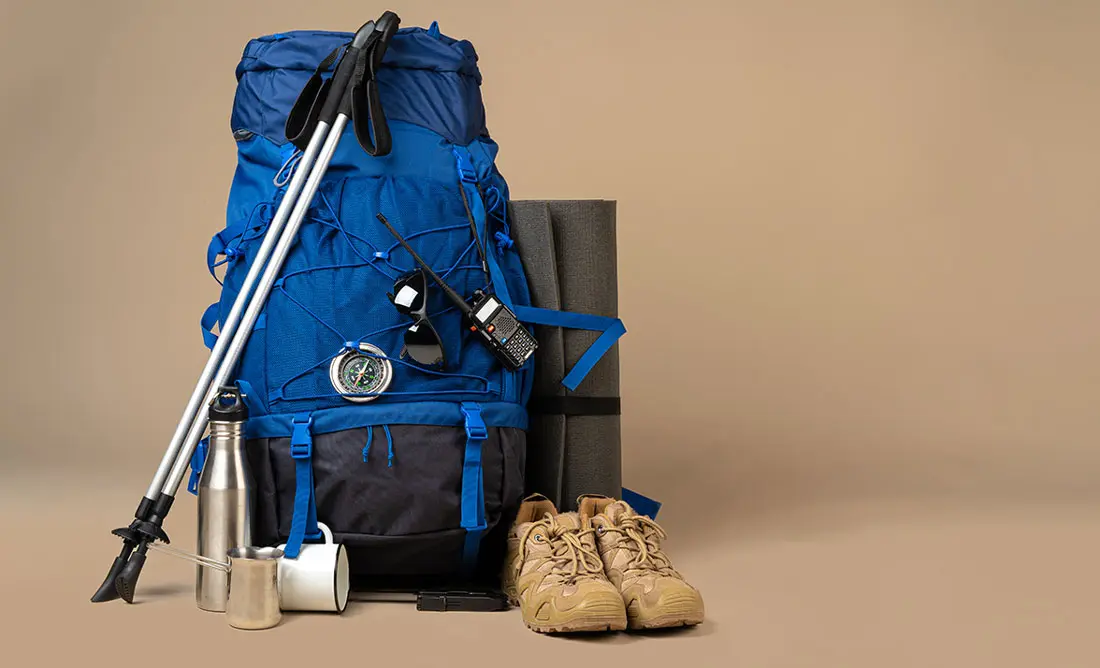
Frequently Asked Questions(FAQ)
To register with TTH, visit our website - www.trekthehimalayas.com and create your account. To create your account you will need to use your email address and fill in all the details, set your unique password and your account is ready to use.
- To book a trek with TTH, you first need to register with us and create an account.
- Choose the trek that you want to do and click on available dates.
- You will land at the login page, fill in the required details.
- Add Participants, choose add-on services click on the Pay now button, choose your preferred payment method, and make the payment. TTH accepts multiple payment options, including credit/debit cards, net banking, and UPI.
- You will receive a confirmation email from TTH with all the necessary details about the trek, including the meeting point, transportation, accommodation, and other important instructions.
- Click Here to watch Video
please send an email to us at info@trekthehimalayas.com or reach out to the numbers provided in the Help and Support section of your Trek Page. We will ensure that your issue is promptly resolved.
To book services such as off-load luggage and transportation, you can find them listed as add-ons. These additional services can be booked at the time of your initial booking. If you miss booking add-ons during the initial reservation, you can log in anytime and easily book 4 days before the departure date add-ons through the platform.
If you have booked the wrong trek or selected the wrong date, don’t worry! You can contact us at +91 9368882322 (Monday to Saturday, 10 AM to 10 PM) or email us at info@trekthehimalayas.com. You can also discuss this with your trek coordinator. Please make sure to inform us at least 10 days before the departure of your trek. Only then can we help you reschedule or arrange another trek for you.
We recommend visiting our "Suggest Me a Trek" page. By filling out the form, our experts will contact you with the best possible trek options based on your preferences and experience level. Alternatively, you can reach out to us via email at info@trekthehimalayas.com or give us a call using the numbers provided on our website for personalized assistance and recommendations.
Family treks differ from regular treks by focusing on ease of difficulty, offering shorter durations for younger participants, Kid-friendly and easily digestible foods, child-friendly activities, maintaining a higher guide ratio for diverse age groups, and implementing additional safety measures for families.
Family Trek with Kids recommendation Only Dayara Bugyal and Chopta Chandrashila Trek.
Minimum age for TTH treks is typically 7 years, though this may vary depending on the specific trek.
Yes, you can take a kids to a high-altitude trek with a parent. Discuss with a trek expert before booking a trek.
- Junior trekkers (below 15 years) should have a company of parents/guardians.
- Trekkers between 15 to 18 years can come solo with the disclaimer form signed by parent/guardian.
- Medical & Disclaimer Form (Mandatory Documents) Click here to download medical and disclaimer form
Physical Fitness: Ensure your child is physically fit. Engage them in regular exercise, outdoor activities, and hikes to build stamina and endurance. Hydration: Emphasize the importance of staying hydrated at high altitudes. Encourage your child to drink water regularly, even if they don't feel thirsty. Proper Nutrition: Provide a well-balanced diet with sufficient carbohydrates for energy and foods rich in iron to prevent altitude sickness. Adequate Sleep: Ensure your child gets enough sleep in the days leading up to the trek. Quality rest is crucial for altitude adaptation. Educate on Altitude Sickness: Teach your child about the symptoms of altitude sickness, such as headache, nausea, and dizziness. Encourage them to communicate any discomfort immediately. Appropriate Clothing and Gear: Dress your child in layers to adjust to changing temperatures. Ensure they have appropriate trekking gear, including sturdy footwear. Positive Mindset: Foster a positive mindset. Encourage your child, and let them know it's okay to take breaks when needed. Medical Check-Up: Schedule a medical check-up before the trek to ensure your child is fit for high-altitude activities. Consult with a healthcare professional about any potential health concerns.
TTH takes special care to provide wholesome and nutritious food for children on treks. Here are some of the foods that are typically served for children:
Breakfast: For breakfast, TTH serves a variety of options like porridge, cornflakes, bread, butter, jam, honey, boiled eggs, omelettes, and pancakes. Children can choose from these options to fuel themselves for the day's trek.
Lunch: For lunch, TTH serves lunch which includes rotis, vegetables, rice, dal, and salad. The rotis are usually made fresh on the trek and are a good source of carbohydrates. The dal and vegetables provide protein and other essential nutrients.
Snacks: TTH provides healthy snacks like fresh fruits, dry fruits, energy bars, cookies, and biscuits to keep the children energized throughout the day.
Dinner: For dinner, TTH serves a hot and wholesome meal which includes soup, rice, dal, vegetables, and a non-vegetarian dish (if requested in advance). Children can also choose from a variety of desserts like custard, jelly, and fruit salad.
Dietary requirements: If a child has any special dietary requirements, TTH can cater to those needs as well. For example, if a child is lactose intolerant or allergic to nuts, the kitchen staff can make arrangements to accommodate those requirements.
Choosing the right trek for a beginner can be a bit overwhelming as there are many factors to consider such as distance, elevation gain, terrain difficulty, weather, and time of year. Here are some tips that can help you choose the right trek for a beginner:
1. Determine fitness level: Assess the fitness level of the beginner to understand their physical capabilities. This will help you select a trek that is challenging but not too difficult.
2. Choose a well-traveled trail: A well-traveled trail will have more amenities such as signposts, water stations, and shelter. It is also safer as there will be other hikers on the trail.
3. Consider the length of the trek: For beginners, it is recommended to start with a shorter trek that can be completed in a day or two. This will help them get acclimatized to trekking and build their confidence.
4. Look for gradual elevation gain: Choose a trek with a gradual elevation gain rather than steep ascents. This will make the trek easier and more enjoyable.
5. Check the weather: Check the weather forecast before selecting a trek. Avoid treks during the monsoon season or winter when the trails can be slippery or dangerous.
6. Research the trail: Read about the trail to get an idea of the terrain, altitude, and difficulty level. This will help you select a trek that is suitable for the beginner.
7. Consult with an expert: If you are unsure about which trek to choose, consult our trek expert Mr. Nitin (+91 70600 59773) between 10 AM to 6 PM (Tuesday - Friday). Mr. Nitin will provide you valuable advice and guidance.
Overall, it is important to choose a trek that is enjoyable, challenging but not too difficult, and suitable for the beginner's fitness level and experience.
It is not recommended for a beginner to choose a difficult Himalayan trek. Trekking in the Himalayas can be physically and mentally challenging, especially if you are not used to the high altitude, steep slopes, and rugged terrain. Choosing a difficult trek without the proper experience, fitness level, and preparation can be dangerous and put you at risk of altitude sickness, injury, and other hazards.
If you are a beginner, it is recommended to start with an easier trek and gradually build up your skills and experience. This will help you understand the challenges of trekking in the Himalayas, and also prepare you physically and mentally for a more difficult trek in the future. It is also important to choose a trek that matches your fitness level, experience, and interest.
There is no specific age limit for a beginner trekker. However, it is important to consider your physical fitness, health condition, and personal interests before embarking on a trek. Trekking in the Himalayas can be physically and mentally demanding, and requires a certain level of physical fitness and endurance.
If you have any pre-existing medical conditions or are above a certain age, it is recommended to consult with a doctor before embarking on a trek. It is also important to listen to your body and take breaks as needed during the trek to prevent exhaustion or injury.
We recommend visiting our "Suggest Me a Trek" page. By filling out the form, our experts will contact you with the best possible trek options based on your preferences and experience level. Alternatively, you can reach out to us via email at info@trekthehimalayas.com or give us a call using the numbers provided on our website for personalized assistance and recommendations.
Yes, you can join the trek. We have fixed departure groups where you can simply book your trek and we will take care of curating a group.
Before you start the trek, it is recommended that you make all the necessary phone calls as during the trek you may or may not receive network coverage, once you come back to the Base Camp, you can reconnect with your family via phone once again. You can share your trek coordinator contact detail with your family members to get the latest updates about your trek batch.
At TTH, we provide wholesome and nutritious meals during the trek. The food is vegetarian and includes a variety of dishes such as rice, dal, vegetables, chapati, paratha, pasta, noodles, and soup. We also offer snacks such as biscuits, and salty, and dry fruits during the trek. Special dietary requirements such as vegan, gluten-free, or Jain food can also be arranged if informed in advance.
If you are allergic to some foods, you need to let us know in advance so that we can make arrangements accordingly.
TTH is a trekking company that prioritizes the safety of all its participants, including women trekkers. We have a comprehensive safety system in place, which includes a dedicated team of experienced and trained trek leaders and support staff who are equipped to handle emergency situations and provide first aid.
TTH also takes specific measures to ensure the safety and comfort of women trekkers. They have a separate tent accommodation for women trekkers, female trek leaders, and support staff. They also provide separate toilet facilities for women and encourage a safe and respectful environment for all trekkers.
Moreover, TTH has a strict policy against any kind of harassment and has a zero-tolerance policy towards such incidents. They have a designated Internal Complaints Committee (ICC) to investigate and address any complaints related to harassment or misconduct. Overall, TTH has a good reputation for safety and responsible trekking practices, and women can feel comfortable and safe while trekking with them.
In case you are the only women in the group, we provide a single sleeping arrangement. Also, during the trek, the trek leader will always remain by your side to provide optimum safety and reassurance.
You can reach out to the trek coordinator to inquire about the number of female trekkers and their respective states who have booked the trek. Please note that the trek coordinator cannot disclose personal details of any trekker. Once you've confirmed your booking, a WhatsApp Group will be created for all the trekkers in your batch. This allows you to connect with fellow trekkers before the trek begins.
While many of our treks are led by female trek leaders, however, it is not possible to know which trek leader is assigned to which group. But nonetheless, whether the trek leader is male or female you can be completely assured of your safety and security with us.
Yes, it is possible to trek with periods. However, it is important to take some extra precautions and preparations to ensure a comfortable and safe trekking experience. Here are some tips that can help you trek during your period:
1. Use menstrual hygiene products that you are comfortable with, such as tampons, pads, or menstrual cups. It is recommended to carry enough supplies for the entire duration of the trek.
2. Pack wet wipes, hand sanitizer, and plastic bags to dispose of used hygiene products.
3. Wear comfortable and breathable clothing that allows for easy movement and reduces friction. Avoid wearing tight or restrictive clothing that can cause discomfort.
4. Carry pain relief medication, such as ibuprofen or acetaminophen, in case of menstrual cramps.
5. Stay hydrated and maintain a balanced diet to support your energy levels and overall health.
6. Take breaks as needed and listen to your body. If you feel uncomfortable or experience any unusual symptoms, seek medical attention immediately. It is also recommended to consult with a doctor before going on a trek during your period, especially if you have a pre-existing medical condition or are taking medication.
By taking necessary precautions and being prepared, you can have a safe and comfortable trekking experience even during your period. We provide proper disposal facilities for sanitary pad disposal during the trek.
We offer three person tents with twin-sharing for optimum comfort. A woman trekker will share a tent with another woman trekker and if you are the only woman in the group, you will be given a single accommodation for your comfort and privacy.
Yes, we do provide gears on rent. You can book it using you TTH account directly.
Mountaineering qualified Experienced and first aid certified Trek Leader, First Aid Certify local guide, Cook, helpers and supporting staff.
People suffering from Bronchitis, Asthma, High blood pressure, Epilepsy (got faints), TB , Heart problem or on higher BMI side are strictly not allowed to go on any Himalayan trek. Apart from this if you had any medical history, please let us know.
No. Alcohol and smoking isn’t allowed while on trek. It is totally misconception that it will keep you warm. Your body need to acclimatize properly and for that eat properly and drink enough water; these things will keep you warm.
Toilet tents provide a convenient solution for answering nature's call in the great outdoors. Dry toilets, in particular, offer a highly sanitary approach. By digging a pit and utilizing mud and a shovel, you can easily cover up your waste. This method ensures cleanliness and hygiene while camping or exploring in the forest.
Remember to pack essential toiletries to complete your outdoor bathroom kit and maintain proper personal hygiene during your adventures. With these practices in place, you can enjoy nature while also respecting it.
Layer Up From Head To Toe
Eat Full Meals, never sleep empty stomach
You can keep warmee (if you’re more susceptible to cold).
Use sleeping bag in right way and don’t leave free space in sleeping bag.
For upper body
– Thermal layer
– T-shirt (full-sleeves)
– Fleece T-shirt (for extreme colds)
– Fleece layer
– Thick Jacket/Down Jacket
– Waterproof or Windproof layer (outermost layer, when it is snowing or raining)
- For Lower Body
– Thermal layer
– Hiking pants (normal) or Winter hiking pants
Based on how warm you feel you can skip any of the above layers. Your outer later should be windproof since it is windy at high altitude.
The idea behind layering is that the more insulation you have the less cold you feel, and instead of wearing a very thick jacket if you wear multiple layers, your body will be better insulated against the cold.
Yes, we provide micro spikes and gaiters, if required.
Mandatory documents: 2 xerox of ID having address (addhar card/driving license), 2 Passport size photographs, hard copy Medical form signed & sealed by doctor, disclaimer form sign by trekker and high altitude insurance.
No. We don’t but we can suggest you good hotel/Stay nearby pick up location.
Yes, trekker must carry 2 water bottles 1 litre each so they can refill it at campsite for drinking and keep themselves hydrate.
You should buy shoes which has these three features –Good grip, Ankle Support and additional water resistant layers. Generally, we advise Quechua Trek 100, MH 500 and MH 100.
No one is forced to go on. There is always enough staff to split the party according to need and regroup later at the camp. Most people have no trouble reaching the highest campsite. If some members decide not to climb the final distance they can wait for the climbers to come back down the same way or take a lateral path to the descent route.
The Khopra Ridge Trek is considered a moderate-level trek that requires a reasonable level of fitness and endurance.
The Khopra Ridge Trek requires the Annapurna Conservation Area Permit (ACAP) and the Trekker's Information Management System (TIMS) card.
The highest altitude reached on the Khopra Ridge Trek is around 4,770 meters at Khopra Ridge.
While it is not mandatory to hire a guide for the Khopra Ridge Trek, it is highly recommended for safety and to learn about the local culture.
Accommodation on the Khopra Ridge Trek is typically basic tea houses or lodges with basic facilities such as shared toilets and hot showers.
Pack warm clothing, sturdy trekking shoes, a backpack, a sleeping bag, a headlamp, sunglasses, sunscreen, a first aid kit, a water bottle, and snacks.
Altitude sickness is a risk on the Khopra Ridge Trek, so it is important to acclimatize properly and stay hydrated.
The trail condition on the Khopra Ridge Trek is generally good, but there are some steep and rocky sections that can be challenging.
Landslides can occur on the Khopra Ridge Trek, especially during the monsoon season. It is important to check weather conditions and take precautions.
While it is possible to do the Khopra Ridge Trek solo, it is recommended to have a guide or travel with a group for safety and to learn about the local culture.
The weather on the Khopra Ridge Trek can be unpredictable, but generally clear and dry from March to May and September to December. It can be cold at higher altitudes, especially at night.
The maximum group size for the Khopra Ridge Trek is typically 15 people.
The Khopra Ridge Trek offers opportunities to experience local culture, including visits to traditional villages and monasteries.
